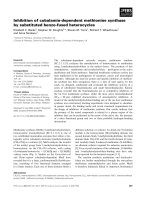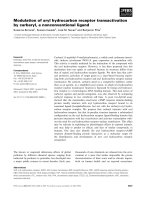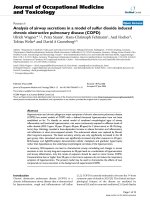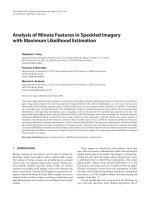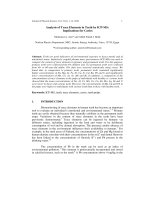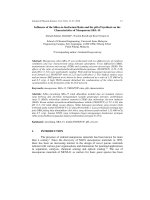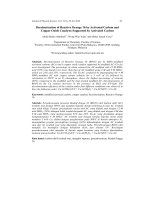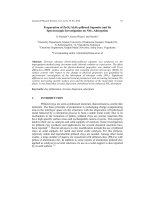Báo cáo vật lý: "Analysis of Trace Elements in Teeth by ICP-MS: Implications for Caries" pptx
Bạn đang xem bản rút gọn của tài liệu. Xem và tải ngay bản đầy đủ của tài liệu tại đây (260.67 KB, 12 trang )
Journal of Physical Science, Vol. 21(2), 1–12, 2010 1
Analysis of Trace Elements in Teeth by ICP-MS:
Implications for Caries
Mohamed A. Amr* and Abdul Fattah I. Helal
Nuclear
Physics Department, NRC, Atomic Energy Authority, Cairo, 13759, Egypt
*Corresponding author:
Abstract: Teeth are good indicators of environmental exposure to heavy metals and of
nutritional status. Inductively coupled plasma-mass spectrometry (ICP-MS) was used to
compare the content of trace elements in primary and permanent teeth. For this purpose,
primary teeth were collected from 64 children and 112 permanent teeth were collected
from 40- to 60-year-old adults. The data were assessed statistically using t-tests. We
found that, in comparison to primary teeth, permanent teeth contained significantly
higher concentrations of Na, Mg, Al, Fe, Ni, Cu, Sr, Cd, Ba, Pb and U and significantly
lower concentrations of Mn, Co, As, Se, Mo and Bi. In addition, a comparison of the
concentrations of trace elements in the pulps of individuals with healthy vs. carious teeth
showed that the mean concentrations of Na, Al, Cr, Mn, Co, Cu, Zn, Mo, Ag, Bi and U
were lower in those with carious teeth. However, the concentrations of Mg, Cd and Pb in
the pulps were higher in individuals with carious teeth than in those with healthy teeth.
Keywords: ICP-MS, teeth, trace elements, caries, teeth pulps
1. INTRODUCTION
Biomonitoring of trace elements in human teeth has become an important
tool to evaluate an individual’s nutritional and environmental status.
1–5
Primary
teeth are easily obtained because they naturally exfoliate as the permanent teeth
erupt. Variations in the content of trace elements in the teeth have been
previously demonstrated.
1
Trace elements can be ingested by humans via
different routes, including ingestion in the food and water or by deliberate
consumption of soil and by dermal absorption. The presence and/or absence of
trace elements in the environment influences their availability to humans.
1
For
example, in the rural areas of Finland, the concentrations of Zn and Mg found in
human dentine correlate with their concentrations in the soil,
6
and dental fluorosis
has been linked to the concentrations of fluoride (F
–
) and Pb present in the
drinking water.
1,4
The concentration of Pb in the teeth can be used as an index of
environmental pollution.
7
This element is preferentially incorporated and stored
in calcified tissues, such as the teeth.
8
A Pb concentration above 4 mg/kg in the
Trace Elements in Teeth: Implication for Caries 2
teeth has been suggested as being indicative of Pb toxicity.
5,9
Here, we have
investigated the importance of the location of trace elements in the teeth, with a
focus on Pb. For this purpose, we have used various techniques, including the use
of microprobes. Our results indicate that trace elements are systematically but
inhomogeneously distributed within the enamel and dentine of teeth.
10
Sources of Cd include emissions from fuel combustion, tobacco smoke,
phosphate fertiliser, sewage sludge, metal smelting, and disposal of metal waste.
Other sources include the use of Cd for industrial applications, such as in the
production of pigments, stabilisers, and alloys. In addition, Cd is present in trace
amounts in certain foods, such as leafy vegetables, potatoes, grains and seeds,
liver and kidney, and crustaceans and molluscs. Exposure to environmental Cd
has been linked with an increased risk of dental caries.
11
Other studies have demonstrated that nutritional deficiencies can be
detected by analysing the chemical composition of teeth and that such
deficiencies can affect teeth during dentition, which is a critical growth period for
teeth.
6–8,10–15
Differences in the availability of foods and food choices, which are
often influenced by social and cultural practices, may be important factors in
determining which trace elements are ingested by humans and can complicate
any attempts at changing dietary habits to alter the intake of trace elements.
Shashikiran et al.
15
found that, among different ethnic groups, there is a lot of
variation in the concentrations of trace elements in teeth enamel.
Teeth pulp occupies the centre of each tooth and consists of soft
connective tissue (Fig. 1). Adult individuals normally have 32 pulp organs in the
permanent teeth, while primary teeth contain 20 pulp organs.
16
The primary and
permanent teeth pulps have a number of characteristics that are morphologically
similar. Each pulp organ resides in a pulp chamber that is surrounded by dentin
and which contains the peripheral extensions of the cells that formed it. Ide-
Ektessabi et al.
17
examined the distribution of trace elements in the layers and in
the pulp of two teeth by X-ray fluorescence using synchrotron radiation
microbeams. They found that the border of the dentine and the pulp contain high
concentrations of Ca, Pb and Zn. Pinheiro et al.
18
investigated how the
environment and dietary habits influence the accumulation of trace elements in
the teeth. For this purpose, they determined the concentrations of different
elements in the enamel, dentine crown, dentine root and the pulp in nine teeth
using synchrotron microprobe radiation. Also using synchrotron microprobe
radiation, Carvalho et al.
19
analysed 40 molar teeth that were previously restored
with dental amalgams to determine how the major components of the amalgam
(Cu, Zn and Hg) diffuse into the structures of the teeth. Curson and Crocker
20
determined the concentrations of Zn and Pb in the pulp of the teeth.
Journal of Physical Science, Vol. 21(2), 1–12, 2010 3
Figure 1: Schematic diagram of a human molar.
El-Kanayat City, Egypt is a rural area, and its inhabitants obtain their
livelihood from agriculture. In addition, the inhabitants of this city drink
underground water, and 99% of the population cooks their meals using metallic
utensils of poor quality. As such, the content of trace elements in the environment
and the foods grown there are likely to be enriched in certain elements, such as
Mg. The aim of this study was to examine the relationship between exposure to
trace elements and dental caries in teeth collected from inhabitants of El-Kanayat
City. We compared primary and permanent teeth as well as the pulps of carious
and healthy, permanent teeth.
2. EXPERIMENTAL
2.1 Instrumentation
An inductively coupled plasma-mass spectrometer (ICP-MS) was used to
measure the concentrations of trace elements. ICP-MS (JMS-PLASMAX2,
JOEL, Japan) was optimised by using a standard
89
Y solution at a concentration
of 10 ppb in 2% HNO
3
. The same 2% HNO
3
solution, without
89
Y, was used to
clean the tubes between measurements. To perform the measurements, we used a
microconcentric nebuliser with a desolvation introduction system (ARDIUS,
CETAC, USA). Table 1 shows the operating parameters used for the ICP-MS
measurements.
dentin
pulp
crown
enamel
Trace Elements in Teeth: Implication for Caries 4
Table 1: Experimental conditions used for the ICP-MS measurements.
RF power
950 W
Reflected RF power
< 2 W
Sampling depth
5 mm
Coolant gas flow rate
14 l/min
Auxiliary gas flow rate
0.3 l/min
Nebuliser gas flow rate
0.95 l/min
Sample uptake rate
0.6 l/min
Mass resolution (m/Dm)
300
Accelerating voltage
6 kV applied on the sampler and skimmer
Acquisition mode
Peak area
Introduction system
Desolvation (ARDIUS)
Optimisation
Maximum ion intensity of 10 ppt of
89
Y
2.2 Collection and Preparation of Primary and Permanent Teeth
A total of 64 primary teeth of all types (incisors, canines and molars)
were collected from 5 to 12-year-old children and 112 permanent teeth from 40-
to 60-year-old adults; all participants lived in EI-Kanayat, Egypt. Table 2
summarises the details of the number and health status of the teeth collected.
Whenever possible, we used caries-free primary and permanent teeth to compare
the trace elements concentrations in both types. The teeth were soaked in H
2
O
2
to
remove connective tissue, washed with deionised water and dried overnight. The
teeth were individually ground and weighed and then digested in 10 ml of HNO
3
using a microwave digestion system (Ethos 1600, Milestone Inc., USA).
Table 2: Summary of the number of teeth and teeth pulps analysed.
Incisors
Canines
Molars
Primary teeth
11
8
45
Healthy permanent teeth
2
3
36
Carious permanent teeth
3
7
61
Healthy teeth pulps
2
3
36
Carious teeth pulps
–
4
58
2.3 Extraction and Preparation of Teeth Pulps
The permanent teeth were classified into two groups; healthy and
carious. Immediately after their extraction from the adult subjects, the crowns of
the teeth were removed and the pulps were collected. As shown in Figure 2, the
pulp tissues were removed using a broach file (size 20). The pulps were then
washed with 1% ultra-pure HNO
3
, dried at 60°C and digested in a mixture of
Figure 2: Shematic diagram of tooth pulp extraction obtained by broach filling.
Table 3: Concentrations of tace elements (ppm) in bovine liver (NIST1577b).
Element
Certified value
Measured value
Error (%)
Na
2420 60
2428 45
0.33
Ca
116 4
113 5
2.59
K
9940 20
9899 22
0.41
Mg
601 28
609 24
1.33
Al*
3
2.9 0.5
3.33
Mn
10 0.5
10.5 0.6
5.00
Co
0.25
0.27 0.08
8.00
Fe
184 5
185 11
0.54
Cu
160 8
159 17
0.63
Zn
127 16
126 19
0.79
As*
0.05
0.04 0.006
20.0
Se
0.73 0.06
0.77 0.05
5.48
Rb
13.7 1.1
14.2 1.5
3.65
Sr
0.136 0.001
0.127 0.001
6.62
Mo
3.5 0.3
3.4 0.5
2.86
Ag
0.039 0.007
0.042 0.006
7.69
Cd
0.5 0.03
0.48 0.05
4.00
Pb
0.129 0.004
0.133 0.019
3.10
Note:* Non-certified values.
Trace Elements in Teeth: Implication for Caries 6
HNO
3
(250µl, 69%) and H
2
O
2
(100µl, 30%) using a microwave digestion system.
After digestion, the pulp samples were cooled in a water bath and brought up to a
volume of 1 ml using deionised water (18.2 MW). Bovine liver (NIST1577b),
obtained from National Institute of Standard and Technology (NIST) was used as
a standard for quality assurance. Table 3 shows the concentrations of trace
elements in bovine liver.
2.4. Statistical Analysis
The data were assessed using the Tukey test with a 95% confidence
level. p values of <0.05 were considered statistically significant. Outlying values,
which were rejected based on their D-values [D = (X
n
– X)/S; where X
n
is a
value, X is the mean, and S is the standard deviation], were omitted from the
analysis in order to make general conclusions.
3. RESULTS AND DISCUSSION
3.1 Trace Elements in Primary and Permanent Teeth
The results obtained from the analysis of trace elements in primary and
permanent teeth are summarised in Table 4. Table 4 shows the concentrations of
known essential elements (such as Cu, Mg and Zn), possible essential elements
(such as Sr) and elements with no known biological role and/or that are
potentially toxic (Al, Cd, Ba, Pb and U) found in primary and permanent teeth.
We found a statistically significant difference in the concentrations of Na, Mg,
Al, Zn, Sr, Pb, Cd and Ba between permanent and primary teeth. The
concentrations were higher in permanent teeth compared to primary teeth.
Additionally, the concentration of Mn, Mo, Ag and Bi also showed statistically
significant differences in primary teeth compared to permanent teeth. The
concentrations were lower in permanent teeth compared to primary teeth. We
found no statistically significant differences in the concentrations of Cr, Fe, Cu,
Ag and U between primary and permanent teeth.
Journal of Physical Science, Vol. 21(2), 1–12, 2010 7
Table 4: Concentrations of trace elements (ppm) in healthy primary and permanent teeth.
Element
Primary teeth
Permanent teeth
p-value
Mean SD (range)
Mean SD (range)
Na
5454 950 (4211–7280)
9000 120 (7054–10030)
0.0003*
Mg
1755 340 (1043–2750)
2800 478 (1500–3700)
0.0009*
Al
17.9 12.3 (3–69.5)
51.4 18.2 (27.5–84)
0.0013*
Cr
0.04 0.01 (0.005–2)
0.05 0.03 (0.03–0.11)
0.1992
Mn
5.5 2 (2.5–8.5)
0.27 0.11 (0.09–1.2)
0.0033*
Fe
80.1 16.5 (28.9–135)
94 23 (65.3–122)
0.0915
Cu
6.4 4.8 (2–11.3)
9.2 11.4 (1.4–26.1)
0.1257
Zn
133 30 (85–166)
178 44.6 (124.6–235.7)
0.0011*
Sr
87 11.3 (60.9–114)
101.2 24.3 (70.2–130)
0.0167*
Mo
1.8 0.29 (1.02–2.33)
0.044 0.012 (0.031–0.067)
0.0007*
Ag
0.08 0.03 (0.004–1.9)
0.009 0.002 (0.005–0.012)
0.1583
Cd
0.00011 0.00001
(0.00007–0.00014)
0.012 0.004 (0.0084–0.016)
0.0012*
Ba
7.8 3.2 (2.06–13.8)
9.5 5.4 (5.11–17.97)
0.042*
Pb
1.2 0.89 (0.34–4.01)
6.26 1.24 (0.6–9.23)
0.0061*
Bi
23 2.34 (16.3–28.5)
0.22 0.09 (1.10–3.01)
0.0061*
U
0.005 0.002 ( 0.001–0.052)
0.011 0.005 (0.0012–0.041)
0.3485
Note: *p ≤ 0.05
3.2 Trace Elements in the Pulps of Healthy and Carious Teeth
The pulp contains the nerves and blood vessels of the teeth. The blood
vessels feed the tooth and keep it alive and healthy. The nerve endings inside the
pulp send signals to the brain about the activity that occurs in the tooth. The
concentrations of trace elements found in the teeth often provide information on
deficiency or disease status, poisoning or contamination. The trace elements most
widely encountered in the teeth include Al, Cd, Ba, K, Li, Mg, Mn, Na, Pb and
Sr. Some of these, such as Cd and Pb, can potentially be toxic. Table 5 shows the
concentrations of trace elements found in the pulps of the teeth.
Trace Elements in Teeth: Implication for Caries 8
Table 5: Concentration of trace elements (ppm) in permanent healthy and carious teeth
pulps.
Element
Healthy teeth pulp
Carious teeth pulp
p-value
Na
1793 342
1385 705
0.2881
Ca
82336 8980
121814 1718
0.0186*
Mg
2733 589
6285 1981
0.0015*
Al
1029 172
1413 422
0.0069*
Cr
42.40 6.29
33.99 9.14
0.0101*
Mn
24.04 4.23
29.84 9.81
0.0325*
Fe
5.85 1.12
1.22 0.36
0.0010*
Cu
270 44
234 59
0.0044*
Zn
1383 254
1303 318
0.1049
Sr
82.09 17.05
106 28
0.0095*
Mo
2.31 0.19
3.29 0.99
0.0136
Ag
55.91 10.41
26.07 6.84
0.0045*
Cd
1.98 0.27
6.70 1.18
0.0019*
Ba
18.94 2.05
34.60 8.43
0.0047*
Pb
29.23 4.13
77 21.2
0.0031*
Bi
35.98 3.47
12.55 3.67
0.0037*
U
0.91 0.38
0.97 0.28
0.3270
Note: *p ≤ 0.05
We found a statistically significant difference in the concentrations of Al,
Mg, Sr, Cd, Ba and Pb between the pulps of healthy and carious teeth. The
concentrations were lower in healthy teeth pulps than carious teeth pulps. On the
other hand, we found that the concentrations of Cr, Fe, Cu, Ag and Bi also
showed statistically significant differences in the pulps of carious teeth compared
to those of healthy teeth. However, there was no statistically significant
difference in the concentrations of Na, Zn and U between primary and permanent
teeth. Moreover, after normalising the mean concentrations of trace elements to
that of Ca, we found that the concentrations of Al, Cr, Mn, Co, Fe, Ni, Cu, Zn,
Sr, Mo, Ag, Bi and U are lower in the pulps of carious teeth than in those of
healthy teeth, and the mean concentrations of Mg, Cd, Ba and Pb were higher in
the pulps of carious teeth than in those of healthy teeth (Fig. 3).
Journal of Physical Science, Vol. 21(2), 1–12, 2010 9
Figure 3: Comparison of the trace element/Ca ratio in teeth pulps.
The information on the concentrations of trace elements present in the
pulps of teeth is scarce and contradictory.
18–20
Carvalho et al.
19
measured the
concentrations of Mn, Fe, Cu, Zn and Pb in the pulps of restored and healthy
teeth using a synchrotron microprobe. They found that the concentrations of Mn,
Fe, Cu, Zn and Pb in the pulps of restored teeth were 5±3, 16±6, 43±20, 570±120
and 43±25, respectively. In contrast, the concentrations of Mn, Fe, Cu, Zn and Pb
in pulps from healthy teeth were 1.7±1.2, 2±111, 2.3±1.4, 286±50 and 46±15,
respectively. Also, the concentration of Zn in teeth pulp from miners and
fishermen was found to be 541 ppm and 583 ppm, respectively
18
, and in pulps
from healthy and restored teeth the concentrations were 286 ppm and 570 ppm,
respectively
19
; these concentrations of Zn are within the normal range (218–520
ppm) for healthy teeth.
20
In our study, we found that the concentrations of Zn
measured in the pulps of healthy and carious teeth were 138±3254 and 1303±318
ppm, respectively.
As shown in Table 5 Mg is one of the most abundant elements in the
pulp of carious teeth. The mean concentrations of Mg in the pulps of healthy and
carious teeth were 2733±589 and 6285±1981 ppm, respectively. The element
important for the functions of nerves and muscles, as well as for the regulation of
blood pressure is Na.
21
An important ion that is found in the intracellular fluid of
cells is K; along with Na, K is important for the maintenance of electrical
potential in the nervous system and, therefore, for the efficient functioning
of nerves and muscles. The mean concentrations of Na in healthy and
carious permanent teeth were 1793±342 and 1385±705 ppm, respectively.
The concentrations of Cd in the pulps of healthy and carious teeth were
1.98±0.27 and 6.70±1.18 ppm, respectively. Shearer et al.
22
showed that rats
Element/Ca ratio
Element
Healthy
Carious
Trace Elements in Teeth: Implication for Caries 10
exposed to Cd during the neonatal period developed severe dental caries and that
this effect was not prevented by adding F
–
to the drinking water.
4. CONCLUSION
Here, we analysed the concentrations of 16 trace elements in whole
permanent teeth and pulps. The concentrations of Mg, Cd, Pb and Ba were higher
in permanent teeth compared to primary teeth and higher in carious teeth pulps
compared to healthy teeth pulps. Moreover, the ratios of the concentrations of
Mg, Cd, Pb and Ba to those of Ca were higher in pulps from carious teeth than in
those from healthy teeth. According to these observations, we conclude that the
trace elements Mg, Cd, Pb and Ba are positively associated with caries.
5. ACKNOWLEDGEMENT
The authors would like to acknowledge the staffs at EI-Kanayat Dental
Centre, and the Ministry of Health, Egypt for providing the teeth samples and
extraction of teeth pulps.
6. REFERENCES
1. Brown, C. J., Chenery, S. R. N., Smith, B., Mason, C., Tomkins, A.,
Roberts, G. J., Sserunjogi, L. & Tiberindwa, J. V. (2004). Environmental
influences on the trace element content of teeth: Implications for disease
and nutritional status. Arch. Oral Biol., 49(9), 705–717.
2. Kaličanin, B. M. & Nikolić, R. S. (2008). Potentiometric stripping
analysis of zinc and copper in human teeth and dental materials. J. Trace
Elem. Med. Biol., 22(2), 93–99.
3. Chew, L. T., Bradley, D. A., Mohd, A. Y. & Jamil, M. M. (2000). Zinc,
lead and copper in human teeth measured by induced coupled argon
plasma atomic emission spectroscopy (ICP-AES). Appl. Radiat. Isot.,
53(4), 633–638.
4. Grünke, K., Stark, H. J., Wennrich, R. & Franck, U. (1996).
Determination of traces of heavy metals (Mn, Cu, Zn, Cd and Pb) in
microsamples of teeth material by ETV-ICP-MS. Fresenius' J. Anal.
Chem., 354(5–6), 633–635.
5. Al-Mahroos, F. & Al-Saleh, F. S. (1997). Lead levels in deciduous teeth
of children in Bahrain. Ann. Trop. Paediatr., 17(2), 147–154.
Journal of Physical Science, Vol. 21(2), 1–12, 2010 11
6. Lappalainen, R., Knuuttila, M. & Salminen, R. (1981). The
concentrations of Zn and Mg in human enamel and dentine related to age
and their concentrations in the soil. Arch. Oral Biol., 26(1), 1–6.
7. Gulson, B. & Wilson, D. (1994). History of lead exposure in children
revealed from isotopic analyses of teeth. Arch. Environ. Health, 49(4),
279–283.
8. Martin, R. R., Naftel, S. J., Nelson, A. J., Feilen, A. B. & Narvaez, A.
(2007). Metal distributions in the cementum rings of human teeth:
Possible depositional chronologies and diagenesis. J. Archaeology Sci.,
34(6), 936–945.
9. Carvalho, M. L., Karydas, A. G., Casaca, C., Zarkadas, C., Paradellis, T.,
Kokkoris, M., Nsouli, B. & Cunha, A. S. (2001). Fluorine determination
in human healthy and carious teeth using the PIGE technique. Nucl.
Instrum. Methods Phy. Res., Sect. B, 179(4), 561–567.
10. Budd, P., Montgomery, J., Evans, J. & Barreiro, B. (2000). Human tooth
enamel as a record of the comparative lead exposure of prehistoric and
modern people. Sci. Total Environ., 263(1–3), 1–10.
11. Arora, M., Weuve, J., Schwartz, J. & Wright, R. O. (2008). Association
of environmental cadmium exposure with pediatric dental caries.
Environ. Health Perspect, 116(6), 821–825.
12. Carvalho, M. L., Marques, A. F., Marques, J. P. & Casaca, C. (2007).
Evaluation of the diffusion of Mn, Fe, Ba and Pb in Middle Ages human
teeth by synchrotron microprobe X-ray fluorescence. Spectrochim. Acta,
Part B, 62(6–7), 702–706.
13. Shafer, M. M., Siker, M., Overdier, J. T., Ramsl, P. C., Teschler-Nicola,
M. & Farrell, P. M. (2008). Enhanced methods for assessment of the
trace element composition of Iron Age bone. Sci. Total Environ., 401
(1–3), 144–161.
14. Budd, P., Montgomery, J., Cox, A., Krause, P., Barreiro, B. & Thomas,
R. G. (1998). The distribution of lead within ancient and modern human
teeth: Implications for long-term and historical exposure monitoring. Sci.
Total Environ., 220(2), 121–136.
15. Shashikiran, N. D., Subba Reddy, V. V. & Hiremath, M. C. (2007).
Estimation of trace elements in sound and carious enamel of primary and
permanent teeth by atomic absorption spectrophotometry: An in vitro
study. Indian J. Dent. Res., 18(4), 157–162.
16. Alomary, A., Al-Momani, I. F. & Massadeh, A. M. (2006). Lead and
cadmium in human teeth from Jordan by atomic absorption spectrometry:
Some factors influencing their concentrations. Sci. Total Environ., 369
(1–3), 69–75.
17. Ide-Ektessabi, A., Shirasawa, K., Koizumi, A. & Azechi, M. (2004).
Application of synchrotron radiation microbeams to environmental
monitoring. Nucl. Instrum. Methods Phys. Res., Sect. B, 213, 761–765.
Trace Elements in Teeth: Implication for Caries 12
18. Pinheiro, T., Carvalho, M. L., Casaca, C., Barreiros, M. A., Cunha, A. S.
& Chevallier, P. (1999). Microprobe analysis of teeth by synchrotron
radiation: Environmental contamination. Nucl. Instrum. Methods Phys.
Res., Sect. B, 158(1), 393–398.
19. Carvalho, M. L., Marques, J. P., Brito, J., Casaca, C. & Cunha, A. S.
(2002). Hg, Bi, Cu and Zn distribution in human teeth treated by dental
amalgam measured by synchrotron microprobe. Nucl. Instrum. Methods
Phys. Res., Sect. B., 196(1–2), 148–154.
20. Curson, M. E. J. & Crocker, D. C. (1978). Relationships of trace
elements in human tooth enamel to dental caries. Arch. Oral. Biol., 23(8),
647–653.
21. Underwood, E. J. (1971). Trace elements in human and animal nutrition,
3
rd
ed. New York and London: Academic Press.
22. Shearer, T. R., Britton, J. L. & DeSart, D. J. (1980). Influence of post-
developmental cadmium on caries and cariostasis by fluoride. Environ.
Health Perspect., 34, 219–221.
